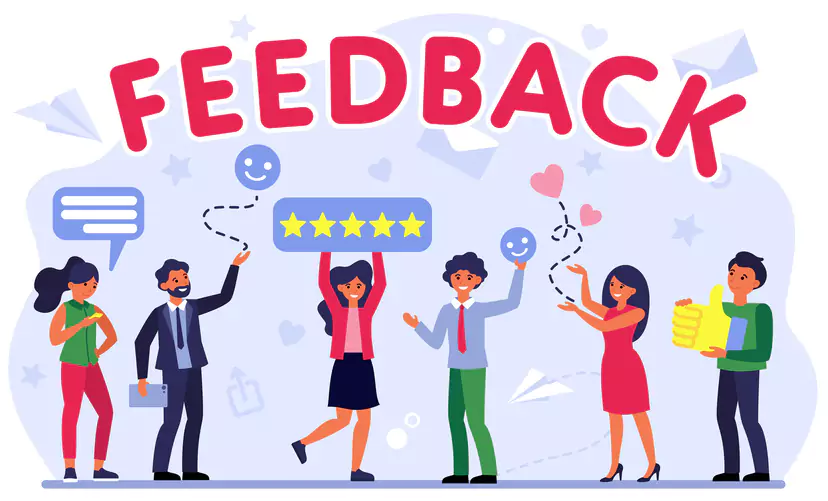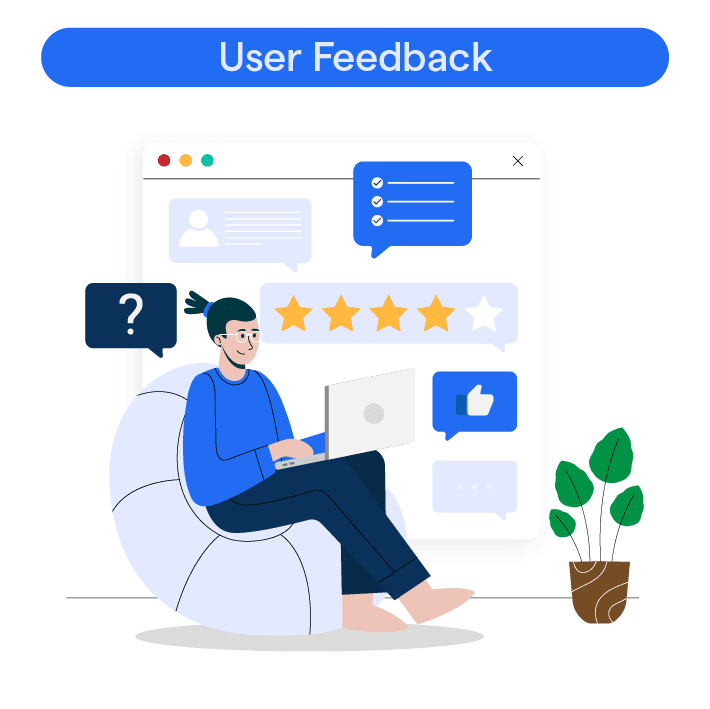What is User Feedback?

User feedback is the information, opinions, and insights provided by users or customers about a product, service, or experience. It helps businesses and developers understand how well they meet user needs, expectations, and preferences.
Importance of User Feedback
User feedback is crucial for several reasons:
It provides insights into how users perceive and interact with a product or service.
It helps identify areas of improvement and potential new features.
It allows businesses to measure user satisfaction and make informed decisions.
Types of User Feedback
User feedback can be categorized into:
Positive feedback: Praise or compliments about the product, service, or experience.
Negative feedback: Criticisms or complaints that highlight issues or areas for improvement.
Constructive feedback: Suggestions and recommendations for improvement, often accompanied by specific examples.
Why Collect User Feedback?
Improve User Experience
Collecting user feedback helps businesses understand their users' needs, preferences, and pain points. This information can be used to enhance the overall user experience, making it more enjoyable and satisfying.
Identify and Fix Problems
User feedback can reveal issues that may not be apparent to the development team. By identifying and addressing these problems, businesses can improve their product or service and prevent potential customer dissatisfaction.
Measure Customer Satisfaction
User feedback serves as a valuable metric for gauging customer satisfaction. By regularly collecting and analyzing feedback, businesses can track their performance over time and make adjustments as needed.
Validate Product Features and Ideas
User feedback can help validate new product features or ideas before investing significant resources into development. By gathering user opinions, businesses can ensure they are focusing on features that truly resonate with their audience.
When to Collect User Feedback?
Different Stages of Product Development
User feedback should be collected throughout the product development process, from the initial concept stage to post-launch evaluations. This ensures that user needs and preferences are considered at every step.
Ongoing Feedback Collection
User feedback should be continually collected to monitor user satisfaction and identify any changes in user preferences or needs. This ongoing process allows businesses to stay ahead of the curve and make necessary adjustments.
After Major Updates or Changes
User feedback is especially important after major updates or changes to a product or service. This helps businesses gauge user reactions to the changes and identify any new issues that may have arisen.
Who Should Provide User Feedback?
Target Audience

The target audience for a product or service should be the primary source of user feedback. These individuals are most likely to provide valuable insights and suggestions for improvement.
Existing Customers
Existing customers can offer valuable feedback based on their experiences with a product or service. They can provide insights into what works well and what could be improved.
Internal Stakeholders
Internal stakeholders, such as employees and team members, can also provide useful feedback. Their unique perspectives can help identify potential issues and areas for improvement.
How to Collect User Feedback?
Collecting user feedback is essential for understanding how your customers perceive your product or service. Here are some common methods for gathering feedback:
Surveys and Questionnaires

Surveys and questionnaires are a popular way to collect user feedback. They can be distributed via email, embedded on websites, or shared on social media. These tools usually consist of multiple-choice questions, rating scales, and open-ended questions.
Usability Testing
Usability testing involves observing users as they interact with your product or service. This can help identify any issues or areas for improvement. Usability testing can be conducted in person or remotely using screen-sharing tools.
Interviews and Focus Groups
Interviews and focus groups involve having in-depth conversations with users to gather detailed feedback. Interviews are typically one-on-one, while focus groups involve a small group of users discussing their experiences together.
Feedback Forms and Widgets
Feedback forms and widgets can be embedded on your website or app, allowing users to submit feedback directly. These can include star user ratings, comment boxes, or even interactive tools like chatbots.
Social Media and Online Reviews
Social media platforms and online review sites are a goldmine for user feedback. Monitor your brand's social media channels and review sites like Yelp or Google Reviews to gather feedback from customers.
Analyzing and Acting on User Feedback
Once you've collected user feedback, it's crucial to analyze it and make data-driven decisions. Here are some steps to help you make sense of the feedback:
Organizing and Categorizing Feedback
Sort and categorize feedback into themes or topics to make it easier to analyze. This can be done manually or using text analysis tools.
Identifying Trends and Patterns
Look for recurring themes or patterns in the feedback. This can help you identify common issues or areas where users are consistently satisfied or dissatisfied.
Prioritizing Feedback
Not all feedback is created equal. Prioritize feedback based on factors like urgency, impact on user experience, and alignment with your business goals.
Implementing Changes Based on Feedback
Use the insights gained from your analysis to make informed decisions about product or service improvements. Keep users informed about the changes you're making based on their feedback.
Tools and Platforms for User Feedback
There are various tools and platforms available to help you collect, analyze, and act on user feedback. Some popular options include:
Survey and Polling Tools
Tools like SurveyMonkey, Google Forms, or Typeform can help you create and distribute surveys and questionnaires to collect user feedback.
Usability Testing Platforms
Usability testing platforms like UserTesting, Lookback, or Optimal Workshop allow you to conduct remote or in-person usability tests to gather feedback on your product's user experience.
Feedback Management Software
Feedback management software like UserVoice, Canny, or Zendesk can help you organize, analyze, and prioritize user feedback more efficiently.
Best Practices for Collecting User Feedback
To get the most out of your user feedback efforts, follow these best practices:
Ask Specific and Clear Questions
Craft questions that are easy to understand and focus on specific aspects of your product or service. This will help you gather more actionable feedback.
Be Open and Receptive to Feedback
Encourage users to share their honest opinions and make it clear that their feedback is valued. This can help build trust and foster a positive relationship with your users.
Incentivize Feedback Participation
Offer rewards, discounts, or other incentives to encourage users to participate in your feedback initiatives. This can help increase response rates and show users that their opinions are valued.
Ensure Anonymity and Confidentiality
Protect users' privacy by ensuring that their feedback is anonymous and kept confidential. This can encourage more honest and open feedback.
Challenges and Limitations of User Feedback
Collecting, analyzing, and implementing user feedback is crucial for the growth and success of any product or service. However, there are several challenges and limitations when it comes to handling user feedback. In this glossary, we'll explore some of these challenges and provide insights on how to overcome them.
Biased or Inaccurate Feedback
One of the most common challenges in dealing with user feedback is the presence of biased or inaccurate information. This can occur for a variety of reasons, such as:
Confirmation bias: Users may provide feedback that supports their existing beliefs or preferences, rather than objectively evaluating the product or service.
Recency bias: Users might focus on their most recent experiences and overlook past interactions, leading to feedback that doesn't accurately represent their overall experience.
Social desirability bias: Users may feel pressured to provide positive feedback, even if their true feelings are different, in order to be perceived as likable or polite.
Misunderstandings: Users might not fully understand the product or service, leading to feedback based on incorrect assumptions or misconceptions.
To overcome these biases, consider using a mix of quantitative and qualitative feedback methods, such as surveys, interviews, and analytics data. This will help you gather a more accurate and diverse range of user opinions.
Overwhelming Amounts of Feedback
Another challenge in handling user feedback is managing the sheer volume of information. As your product or service grows, you may receive feedback from various channels, such as social media, email, support tickets, and more. This can quickly become overwhelming and make it difficult to identify and prioritize the most valuable insights.
To tackle this issue, consider the following strategies:
Categorize and prioritize feedback: Organize feedback into categories (e.g., usability, performance, design) and prioritize it based on factors such as severity, frequency, and potential impact.
Use feedback management tools: There are numerous tools available that can help you collect, analyze, and manage user feedback more efficiently. Some popular options include UserVoice, Intercom, and Zendesk.
Delegate and collaborate: Encourage team members to take ownership of specific feedback categories or channels. This will help distribute the workload and ensure that all feedback is addressed in a timely manner.
Balancing Feedback with Business Goals
Lastly, it's essential to balance user feedback with your overall business goals and objectives. While it's important to listen to your users, not all feedback will align with your strategic vision or be feasible to implement.
To strike the right balance, keep these tips in mind:
Evaluate feedback in context: Consider how each piece of feedback fits into your overall product strategy and roadmap. Does it align with your goals, or would implementing it require a significant shift in direction?
Identify trends and patterns: Look for recurring themes or patterns in user feedback. This can help you identify areas where multiple users are experiencing issues or expressing similar desires, which may warrant further investigation or prioritization.
Communicate openly with users: Be transparent about your decision-making process and explain why certain feedback may not be implemented. This can help build trust and understanding between you and your users, even if you're unable to accommodate all of their requests.
In conclusion, handling user feedback can be challenging, but it's an essential aspect of product development and growth. By understanding the limitations, managing the volume of feedback, and balancing it with your business goals, you'll be better equipped to make informed decisions and create a product that truly resonates with your users.
Frequently Asked Questions
How can I collect user feedback for my product?
To collect user feedback, you can use methods like surveys, feedback forms, user testing, social media listening, and customer support channels. Choose the approach that works best for your audience and product.
What should I do with user feedback?
Analyze user feedback to identify patterns and insights. Use it to improve your product by addressing pain points, adding requested features, and enhancing the overall user experience.
How do I encourage users to provide feedback?
Make it easy for users to provide feedback by offering clear channels like feedback forms or in-app prompts. Incentives, such as rewards or discounts, can also encourage participation.
How do I handle negative user feedback?
Respond to negative feedback with empathy and a willingness to understand the user's perspective. Address their concerns, offer solutions, and strive to turn a negative experience into a positive one.
How often should I seek user feedback?
Regularly seek user feedback throughout the product lifecycle. It's beneficial to gather feedback during the initial development stages, after product updates, and on an ongoing basis to continuously improve your product.

